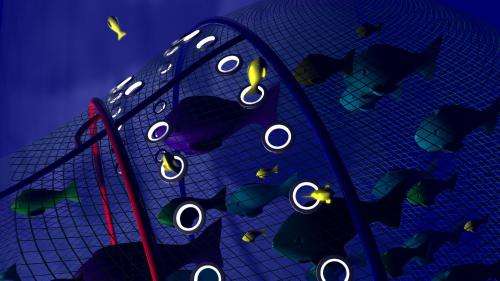August 31, 2012 report
High-Tech fishing net finalist for Dyson Award

Bob Yirka
news contributor

(Â鶹ÒùÔº)—Dan Watson, a Glasgow School of Art graduate, has won the UK leg of the James Dyson award for his innovative fishing net rings that light up and guide smaller fish through nets meant for larger prey. Called SafetyNet, the rings prevent smaller fish being thrown back dead into the sea after being culled. He along with seventeen other finalists will vie for the prestigious grand prize which will be announced November 8.
Trawler fishing is where boats move slowly over the surface of the water with nets hanging down to capture fish swimming below. Unfortunately, the nets catch everything in their path, including those that are too small to sell. Fishermen are forced to sort out the big from the small resulting in a lot of time spent and dead fish being tossed back into the sea. Watson, with his SafetyNet, hopes to change that.
The rings are big enough for small fish to swim through, but not so big that larger fish can do the same. They are sewn into the net, in effect, creating holes, just at the part of the net where the fish are pushed due to current flow. The rings also light up, helping the little fish see where the outlets are, serving as guide signs. And that's not all, one variant of the rings uses kinetic energy derived from water rushing through the rings to power the lights, the other uses batteries.
The James Dyson Award was established by the James Dyson Foundation to reward innovative designs and to inspire new ways of thinking by college students or those, such as Watson, who have recently graduated. The winner, in addition to worldwide accolades also receives £10,000 for him or herself, another £10,000 for their school and a certificate.
Because the rings are made of hard plastic, they prevent the collapse or tears that would occur were the nets to simply have small holes cut in them. Watson has already sea tested the nets, of course, and the results were good enough to push him to the finals. He believes that if commercial fishermen would add the rings to their nets, on average about 20 would be needed for each net, fish populations would rise and fishermen would save time on not having to cull. He expects the rings would cost about £25 apiece once produced in mass quantities.
Written for you by our author —this article is the result of careful human work. We rely on readers like you to keep independent science journalism alive. If this reporting matters to you, please consider a (especially monthly). You'll get an ad-free account as a thank-you.
More information:
© 2012 Â鶹ÒùÔº


















